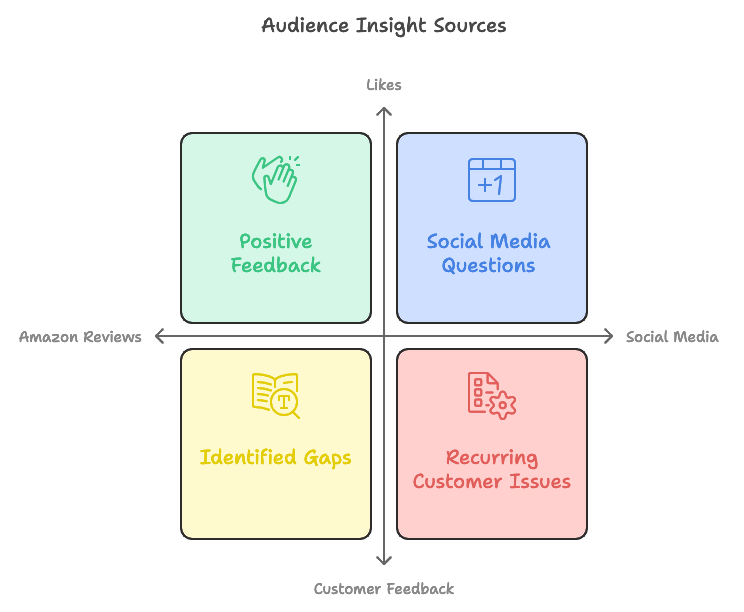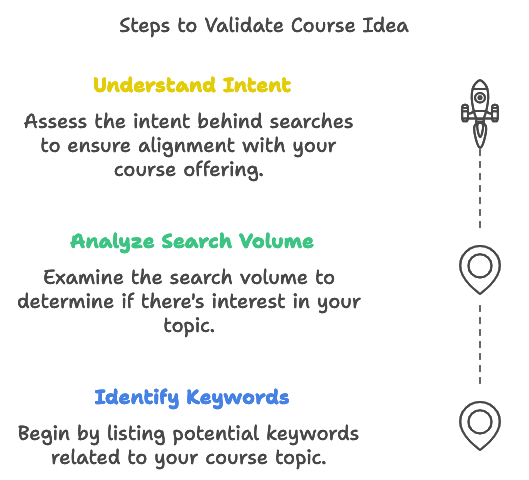Market Research Template: 7 Steps to Validate Your Course Idea Before You Create It
Why Market Research Is Crucial for Your Course’s Success
If you’re a coach or speaker and you’ve ever dreamed of making money while you sleep… ditching the “hours for dollars” grind… you know the potential power of creating an online course. But here’s the harsh truth: imagine spending weeks, maybe even months, pouring your heart into creating that course, only to launch it to crickets. No one buys. No one cares. It’s a nightmare—and it’s one that way too many creators go through when they skip market research.
Market research isn’t just about finding out if your course is a good idea. It’s also about discovering how you can look fresh, feel new, and stand out in a crowded market. Because let’s be real: your course probably isn’t the first one your target audience has ever come across to solve their problem. So how do you make it clear that yours is the one they’ve been looking for? How do you make them see your course as the fresh solution that finally gets it right?
That’s where these research methods come in. Validating your course idea isn’t about complex data analysis or running a focus group —it’s about understanding your audience so well that you create something they not only need but are excited to buy.
In this post, I’m going to show you a simple, no-nonsense market research template that’ll help you figure out if your target market wants your course before you invest your time and energy. Let’s make sure you’re set up for success from the start.

Step 1: Identify Your Audience’s Pain Points
A solid course idea starts with solving a real problem. Ask yourself: What’s the pain point your course is going to solve? You’ve got to know your audience and really dial in on a niche. If you’re thinking about building a course on digital marketing, don’t just stop there—narrow it down. Maybe it’s Facebook ads for handmade businesses. Get specific.
How to Identify Pain Points:
- Read the Reviews on Amazon: Check out the reviews on books your audience would read. What do they like? What’s missing for them? What do they say they find difficult? Read between the lines. What do they ultimately want? ( Amazon can be a gold mine for info. It’s completely free market research.)
- Social Listening: Hang out where your people are—Facebook groups, Reddit, Quora. Pay attention to what questions they’re asking.
- Customer Feedback: Sold products or services before? Go back and look at what people have said. What keeps coming up?

When you know your audience’s pain points inside and out, you can create a course that makes them think, “I need this now!” That’s when you’re onto something powerful.
Use what you discover to create a buyer persona. And get beyond just demographics.
Step 2: Analyze Your Competition
Don’t shy away from competition—embrace it. Your competitors can give you a goldmine of insights into what’s working and what isn’t. Research courses similar to your idea and take note of these key points:
- Pricing: Are similar courses priced high or low? This can help you decide where to position yours.
- Reviews: Dive into the reviews on competitors’ courses. What are people raving about? What are they complaining about?
- Content Gaps: Look for the holes in the competition’s content. If their courses leave a lot of questions unanswered, that’s your opportunity to step in and do it better.
Pro Tip: Use Udemy or Coursera
Check out platforms like Udemy or Coursera to see what courses are killing it. These platforms are packed with info on what’s hot, what people love, and what they’re willing to pay for. Use that to your advantage to better understand the pains and aspirations of your buyers.
This is how you customize your new product as the solution they need.
Fastest way to grow brand awareness is to be perceived as a completely NEW mechanism.
Step 3: Conduct Keyword Research
Keyword research is a crucial part of making sure your course idea is actually something people want. It shows you if folks are out there actively searching for a solution you plan to provide. Tools like Google Keyword Planner, Ahrefs, or Ubersuggest are great for this.
How to Get Started:
- Identify Keywords: Jot down potential keywords related to your course.
- Analyze Search Volume: Check out the search volume. If nobody’s searching for your topic, it could mean you’ve found an untapped niche—or it could mean there’s no demand. Be smart about it.
- Understand Intent: Are your buyers aware of their problem and looking for a solution. Or are they aware of existing solutions? Are they searching for those? Consider the difference between. “How do I sell my course online” v “What’s the best shopping cart?” v “Thrivecart offer”.
Keyword research doesn’t just validate your idea—it lays the groundwork for how you’re going to market your course effectively down the road.
No market research report template is complete without this. So add all of this to your market research plan. Then let your mind work on it to deliver you actionable insights.

Step 4: Test the Market with a Lead Magnet
One of the best ways to find out if your course idea has legs and to understand the market you’re in, is to put out a simple lead magnet. It could be an ebook, a free checklist, or even a mini video series. Offer it up in exchange for an email address.
If people are willing to give you their email, they’re showing real interest in your topic. From there, track the sign-ups and engagement to see if you’ve got something hot. If no one bites, it’s time to rethink your approach or tweak your topic.
Once people are on your list, you can ask them questions directly. The best way to get answers to your research questions is to just ask them.
Example Lead Magnets:
- A checklist for launching your first Facebook ad.
- A free webinar on avoiding common mistakes in digital marketing.
- A short guide on handmade business branding.
- A free template which solves a specific an immediate problem
Step 5: Interview Your Target Audience
Conversations That Count
Never underestimate the power of a good conversation. One-on-one interviews can give you the kind of depth that a market research survey can’t always capture.
Talking to real people is where you find out what’s really going on—the hopes, fears, and frustrations that a survey just can’t reveal. It’s a chance to dig deep.
Pro-tip: if you’re a coach, then talking to clients is real in-depth market research. Coaching clients will share things they wouldn’t share with anyone else normally.
And not something you’d ever find on a typical survey template.
It’s why I’m a big fan of coaching the audience you want to create a course for… first.
Questions to Ask:
- What’s your biggest struggle with [your course topic]?
- What would a perfect solution look like for you?
- Have you tried to solve this issue before? What worked or didn’t work?
These interviews will help you understand your target audience on a deeper level. Plus, they’ll give you the exact words your potential buyers use—so you can craft course marketing that hits home and makes them think, “This is exactly what I need.”
Step 6: Pre-Sell Your Course
Pre-Selling: The Ultimate Validation
Pre-selling destroys the problem of “revealed versus stated preferences.” Here’s the deal: people often say they’re interested in something (stated preferences), but when it comes time to actually put money down, their true feelings are revealed (revealed preferences).
It’s a real problem with your average market survey.
By asking people to pay upfront, you’re cutting through the talk and getting to the truth—do they value this enough to pay for it? If they do, you’ve got the real deal.
Pre-selling is the ultimate validation technique. You put your course idea out there and see if people are willing to pay for it before you’ve even built it. Not only does pre-selling prove that your concept has real value, but it also brings in the funds you need to create it.
How to Pre-Sell Your Course:
- Create a Sales Page: Build a simple landing page that lays out your course idea clearly and makes it irresistible.
- Set a Pre-Order Price: Offer a discounted rate to those who jump in early. Make them feel like they’re getting in on the ground floor.
- Announce a Timeline: Be upfront about when the course will be ready. Let your audience know the timeline so they know what to expect.
If people are paying upfront, you’ve got validation—plain and simple.
Step 7: Gather Feedback and Iterate
Feedback That Fuels Improvement
Always collect feedback at every stage of your validation process. Whether it’s from a market research survey, a one-on-one conversation, or lead magnet engagement, your audience’s feedback will help you refine your course and make it even better.
How to Collect Feedback:
- Follow-Up Surveys: After offering a lead magnet, ask questions about how helpful they found it.
- Engage on Social Media: Create polls or ask for feedback in related Facebook groups.
- Test Content: Post snippets of your course content as social media posts and see how people react.
The goal here is continuous improvement—each piece of feedback helps you build a course that’s guaranteed to resonate with your audience. This research project means you’re not just guessing—you’re building something your audience truly wants, and that’s how you make an impact.
FAQs About Validating Your Course Idea
1. How Long Should I Spend on Market Research?
It depends on your industry, but in general, 2-4 weeks is enough for solid market research. Remember, the goal here is validation—not perfection.
2. What Tools Do I Need for Market Research?
- Google Forms or SurveyMonkey for surveys.
- Google Keyword Planner for keyword analysis.
- Facebook and LinkedIn Groups for social listening.
3. Can I Validate My Course Idea Without an Audience?
Absolutely! Focus on social media groups, forums, and even run small ads to test interest. You don’t need a massive audience; you just need engaged individuals who care about your topic.
4. What Should I Do If My Course Idea Fails Validation?
If your idea doesn’t hit the mark, don’t throw in the towel! Use the feedback to tweak your course topic, adjust your target audience, or focus on a slightly different pain point.
5. How Do I Know My Idea Is Ready to Go?
When your audience actively engages with your lead magnet, gives positive feedback, and pre-orders your course—you’re ready!
Conclusion: The ideal survey is the speed at which you can get paid for your ideas
The Importance of Validating Your Course Idea
Validating your course idea through market research might sound like a bit of a grind, but it’s a step you can’t afford to skip if you want to make sure you’re on the right track. Done right, it minimizes risk and makes sure you’re building something people actually want.
Using this approach, instead of some bland corporate market research survey templates, you’re not just validating your course—you’re laying the groundwork for finding your unique mechanism that will pay off big time.
Start by understanding your audience’s pain points, scoping out the competition, and running tests that prove whether your idea is worth pursuing.
Remember, market research is the key that unlocks a successful, profitable course!
And remember as well, it’s not the topic which makes the difference. Finding unique ways to name your product, to highlight specific strengths and weaknesses is what research gives you. In that sense it’s also brand research.

Here’s an extended FAQ for “More Frequently Asked Questions” on market research, incorporating the requested terms and format:
Q: What is a market research template and how can it help me?
A: A market research template is a pre-designed framework that guides you through the process of conducting market research. It helps structure your research, ensuring you cover all essential aspects. Templates can save time, provide consistency, and make it easier to analyze and present your findings. They’re particularly useful for those new to market research or looking to streamline their process.
Q: What are the main types of market research?
A: The main types of market research include primary and secondary research. Primary research involves collecting new data directly from sources, such as through surveys or interviews. Secondary research involves analyzing existing data from sources like industry reports or government statistics. Other types include quantitative research (dealing with numerical data) and qualitative research (focusing on non-numerical data like opinions and behaviors).
Q: How do I create an effective market research survey?
A: To create an effective market research survey, start by defining clear objectives. Use a mix of question types, including multiple-choice, rating scales, and open-ended questions. Keep the survey concise and focused on your research goals. Consider using market research survey templates as a starting point. Test your survey before full deployment, and ensure it’s designed to gather information about your target market effectively.
Q: What should a comprehensive market research plan include?
A: A comprehensive market research plan should include: 1. Clear research objectives 2. Target audience definition 3. Research methodology (primary, secondary, or both) 4. Data collection methods 5. Timeline and budget 6. Analysis plan 7. Reporting format 8. Action steps based on findings This plan serves as a roadmap for your market research efforts and helps ensure you conduct market research effectively.
Q: How can I conduct market research on a limited budget?
A: To conduct market research on a limited budget: 1. Utilize free market research survey templates 2. Focus on secondary research using freely available resources 3. Conduct online surveys using free or low-cost tools 4. Engage in social media listening 5. Analyze your existing customer data 6. Attend industry events or trade shows 7. Conduct informal interviews with potential customers 8. Use government databases and public libraries for information Remember, even with a limited budget, you can gather valuable insights about your target market.
Q: What are some good examples of market research reports?
A: Good market research reports typically include: 1. Executive summary 2. Research objectives and methodology 3. Key findings and insights 4. Market size and growth potential 5. Customer segmentation analysis 6. Competitive landscape 7. SWOT analysis 8. Recommendations and action steps You can find market research examples and market research report templates online to guide your own report creation. These examples can help you structure your findings and present them in a clear, actionable format.
Q: How can I use market research to improve customer experience?
A: Market research can significantly improve customer experience by: 1. Identifying customer pain points and preferences 2. Understanding customer expectations 3. Segmenting your market for personalized experiences 4. Tracking customer satisfaction over time 5. Gathering feedback on products and services 6. Identifying trends in customer behaviour 7. Testing new ideas before full implementation By continuously using research to understand your customers, you can tailor your offerings and service to better meet their needs, ultimately enhancing their experience with your brand.




